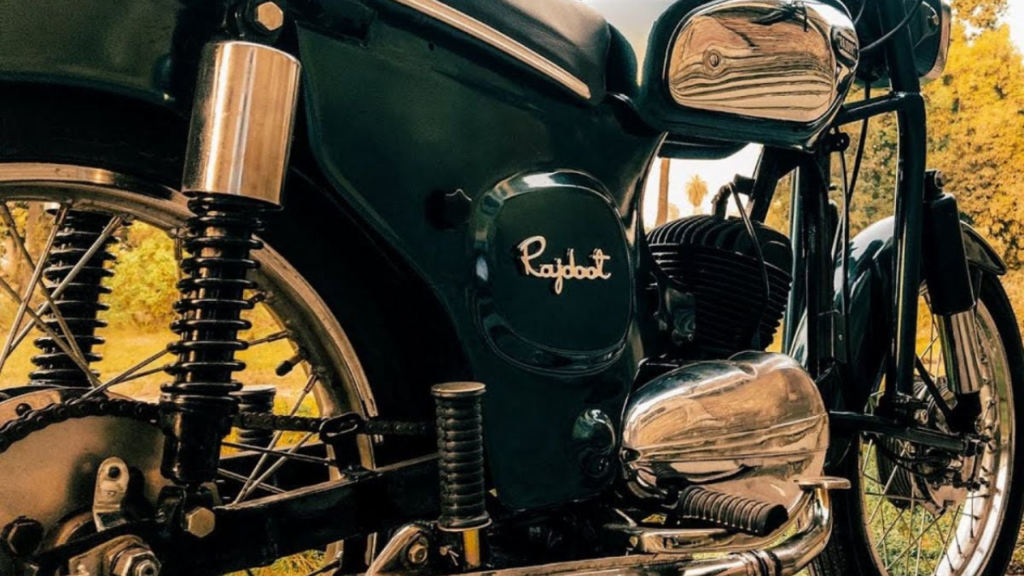Rajdoot Bike: In the annals of Indian motorcycling, few names evoke as much nostalgia and reverence as the Rajdoot. This iconic twowheeler, which graced Indian roads for decades, left an indelible mark on the country’s automotive landscape. From its humble beginnings to its eventual cult status, the Rajdoot’s story is one of innovation, adaptation, and enduring appeal.
Origins: A Polish Connection
The Rajdoot’s tale begins not in India, but in post-World War II Poland. In the 1950s, Polish manufacturer SFM
(Synchron) developed the SHL M11, a 175cc motorcycle based on the German DKW RT 125. This robust and reliable machine caught the eye of India’s Escorts Group, a company looking to diversify its portfolio beyond agricultural machinery. In 1962, Escorts struck a deal to manufacture the SHL M11 in India under license. Thus, the Rajdoot 175 was born, marking the beginning of a new era in Indian motorcycling.

The Rajdoot 175: India’s Workhorse
The Rajdoot 175, affectionately known as the “Rajdoot,” quickly gained popularity across India. Its sturdy build, reliable performance, and ease of maintenance made it a favorite among both urban commuters and rural users. The motorcycle’s versatility was unmatched – it could navigate crowded city streets with ease and tackle rough rural terrain without breaking a sweat. One of the Rajdoot’s most distinctive features was its unique “bobby” design, characterized by a long, flat seat and high handlebars. This design not only gave the motorcycle its iconic look but also made it incredibly comfortable for long rides.
Evolution and Variants
Over the years, the Rajdoot underwent several iterations and improvements. The Rajdoot GTS, introduced in the 1980s, featured a more modern design with a stepped seat and improved ergonomics. This model became particularly popular among young riders and even earned the nickname “Rajdoot Bobby” due to its appearance in the hit Bollywood film “Bobby.” Another notable variant was the Rajdoot 50, a moped-style two-wheeler aimed at providing affordable transportation for the masses. While it didn’t achieve the same level of success as its larger sibling, the Rajdoot 50 demonstrated Escorts’ commitment to catering to diverse market segments.
The Rajdoot 350: A Performance Icon
In 1983, Escorts took a bold step by introducing the Rajdoot 350, a high-performance motorcycle that would change the face of Indian motorcycling. The Rajdoot 350 was essentially a rebadged Yamaha RD350, a legendary two-stroke machine known for its blistering performance.
The Rajdoot 350 was offered in two variants:
1. High Torque (HT) version: Producing 30.5 bhp
2. Low Torque (LT) version: Producing 27 bhp
Despite being detuned from the original Yamaha’s 39 bhp for better fuel efficiency, the Rajdoot 350 was still a force to be reckoned with. It could accelerate from 0-100 km/h in about 7 seconds and reach a top speed of around 160 km/h – figures that were unheard of in the Indian market at the time. The Rajdoot 350’s performance capabilities earned it the nickname “Racing Death,” a moniker that spoke to both its
thrilling speed and the respect (or fear) it commanded on the streets.
Challenges and Decline
Despite its impressive performance, the Rajdoot 350 faced several challenges in the Indian market. Its high price tag, poor fuel efficiency, and expensive maintenance made it a niche product. Moreover, the lack of a front disc brake (replaced with a drum brake to cut costs) raised safety concerns given the motorcycle’s high-speed capabilities. Production of the Rajdoot 350 ceased in 1990, with only about 7,000 units manufactured. However, its legend continued to grow long after it left the production line.
Legacy and Cult Status
Today, the Rajdoot name, particularly the Rajdoot 350, enjoys cult status among Indian motorcycle enthusiasts. Well- maintained or restored Rajdoot 350s can fetch prices upwards of Rs 2 lakh in the used market, a testament to their enduring appeal.
The Rajdoot’s impact on Indian motorcycling culture is undeniable:
1. It introduced Indian riders to levels of performance previously unseen in the domestic market.
2. The motorcycle helped establish Yamaha’s reputation as a performance-oriented brand in India.
3. It paved the way for future high-performance motorcycles in the country.
4. The Rajdoot inspired a generation of motorcycle enthusiasts and continues to influence custom bike builders.
Conclusion: A Timeless Icon
The Rajdoot’s journey from a humble 175cc commuter to a high-performance legend mirrors the evolution of India’s motorcycle market itself. While production may have ceased decades ago, the Rajdoot’s spirit lives on in the hearts of enthusiasts and in the DNA of many modern Indian motorcycles. As India’s two-wheeler market continues to grow and evolve, with an increasing focus on performance and technology, the Rajdoot stands as a reminder of the country’s rich motorcycling heritage. Its legacy serves as an inspiration for future innovations in the Indian automotive industry, ensuring that the Rajdoot name will be remembered and revered for generations to come. In the end, the Rajdoot is more than just a motorcycle; it’s a symbol of India’s journey towards motorization, a testament to the country’s engineering capabilities, and a beloved icon that continues to captivate the imagination of motorcycle enthusiasts across the nation.
